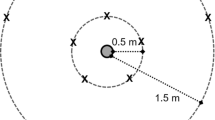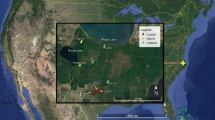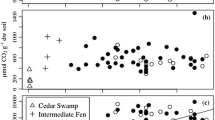Abstract
We investigate temporal changes in methane emissions over a three-year period from two peatlands in Michigan. Mean daily fluxes ranged from 0.6–68.4 mg CH4 m−2d−1 in plant communities dominated by Chamaedaphne calyculata, an eficaceous shrub, to 11.5–209 mg CH4 m−2d−1 in areas dominated by plants with aerenchymatous tissues, such as Carex oligosperma and Scheuchzeria palustris. Correlations between methane flux and water table position were significant at all sites for one annual cycle when water table fluctuations ranged from 15 cm above to 50 cm below the peat surface. Correlations were not significant during the second and third annual periods with smaller water table fluctuations. Methane flux was strongly correlated with peat temperatures at −5 to −40 cm (r s = 0.82 to 0.98) for all three years at sites with flora acting as conduits for methane transport. At shrub sites, the correlations between methane flux and peat temperature were weak to not significant during the first two years, but were strong in the third year.
Low rates of methane consumption (−0.2 to −1.5 mg CH4 m−2 d−1 ) were observed at shrub sites when the water table was below −20 cm, while sites with plants capable of methane transport always had positive net fluxes of methane. The methane oxidizing potential at both types of sites was confirmed by peat core experiments. The results of this study indicate that methane emissions occur at rates that cannot be explained by diffusion alone; plant communities play a significant role in altering methane flux from peatland ecosystems by directly transporting methane from anaerobic peat to the atmosphere.
Similar content being viewed by others
References
Bédard C & Knowles R (1989) Physiology, biochemistry, and specific inhibitors of CH4, NH4 + , and CO oxidation by methanotrophs and nitrifiers. Microbiol. Rev. 53: 68–84
Chanton JP & Dacey JWH (1991) Effects of vegetation on methane flux, reservoirs, and carbon isotopic composition. In: Sharkey T et al. (Eds) Trace Gas Emissions from Plants (pp 65–92). Academic Press, New York
Crill PM, Bartlett KB, Harriss RC, Gorham E, Verry ES, Sebacher DI, Madzar L & Sanner W (1988) Methane flux from Minnesota peatlands. Global Biogeochem. Cycles 2: 371–384
Dacey JWH & Klug MJ (1979) Methane efflux from lake sediments through water lilies. Science 203: 1253–1254
Dise NB (1992) Methane emission from Minnesota peatlands: Spatial and seasonal variability. Global Biogeochem. Cycles 7: 123–142
Dise NB, Gorham E & Verry ES (1993) Environmental factors controlling methane emissions from peatlands in northern Minnesota. J. Geophys. Res. 98 (D6): 10583–10594
Fechner EJ & Herond HF (1992) Methane transport and oxidation in the unsaturated zone of a Sphagnum peatland. Global Biogeochem. Cycles 6: 33–44
Hesslein RH (1976) An in situ sampler for close interval pore water studies. Limnol. Oceanogr. 21: 912–914
Jähne B, Heinz G & Dietrich W (1987) Measurement of the diffusion coefficients of sparingly soluble gases in water. J. Geophys. Res. 92 (C10): 10767–10776
Lansdown JM, Quay PD & King SL (1992) CH4 production via CO2 reduction in a temperate bog: A source of13C-depleted CH4. Geochim. Cosmochim. Acta 56: 3493–3503
McAuliffe C (1971) GC determination of solutes by multiple phase equilibration. Chem. Tech. 1: 46–51
Moore T, Roulet N & Knowles R (1990) Spatial and temporal variations of methane flux from subarctic/northern boreal fens. Global Biogeochem. Cycles 4: 29–46
Moore TR & Knowles R (1990) Methane emissions from fen, bog and swamp peatlands in Quebec. Biogeochem. 11: 45–61
Moore TR & Roulet NT (1993) Methane flux: Water table relations in northern peatlands. Geophys. Res. Lett. 20: 587–590
Nichols DS & Brown JM (1980) Evaporation from a sphagnum moss surface. J. Hydrol. 48: 303–311
Roulet NT (1991) Surface level and water table fluctuations in a subarctic fen. Arctic and Alpine Res. 23: 303–310
Roulet NT, Ash R & Moore TR (1992) Low boreal wetlands as a source of atmospheric methane. J. Geophys. Res. 97 (D4): 3739–3749
Sebacher DI, Harriss RC, Bartlett KB, Sebacher SM & Grice SS (1986) Atmospheric methane sources: Alaskan tundra bogs, an alpine fen, and a subarctic boreal marsh. Tellus 38B: 1–10
Sokal RR & Rohlf FJ (1981) Biometry. W.H. Freeman, San Francisco
Svensson BH & Rosswall T (1984) In situ methane production from acid peat in plant communities with different moisture regimes in a subarctic mire. Oikos 43: 341–350
Whalen SC & Reeburgh WS (1988) A methane flux time series for tundra environments. Global Biogeochem. Cycles 2: 399–409
Whalen SC & Reeburgh WS (1990a) A methane flux transect along the trans-Alaska pipeline haul road. Tellus 42B: 237–249
Whalen SC & Reeburgh WS (1990b) Consumption of atmospheric methane by tundra soils. Nature 346: 160–162
Whalen SC, Reeburgh WS & Sandbeck KA (1990) Rapid methane oxidation in a landfill cover soil. Appl. Environ. Microbiol. 56: 3405–3411
Whalen SC & Reeburgh WS (1992) Interannual variations in tundra methane emission: A 4-year time series at fixed sites. Global Biogeochem. Cycles 6: 139–159
Whiting GJ & Chanton JP (1992) Plant-dependent CH4 emission in a subarctic Canadian fen. Global Biogeochem. Cycles 6: 226–231
Wilson JO, Crill PM, Bartlett KB, Sebacher DI, Harriss RC & Sass RL (1989) Seasonal variation of methane emission from a temperate swamp. Biogeochem. 8: 55–71
Valentine DW, Holland EA & Schimel DS (1994) Ecosystem and physiological controls over methane production in northern wetlands. J. Geophys. Res. 99 (D1): 1563–1571
Yavitt JB & Lang GE (1990) Methane production in contrasting wetland sites: Response to organic-chemical components of peat and to sulfate reduction. Geomicrobiol. J. 8: 27–46
Yavitt JB, Downey DM, Lancaster E & Lang GE (1990a) Methane consumption in decomposing Sphagnum-derived peat. Soil Biol. Biochem. 22: 441–447
Yavitt JB, Lang GE & Sexstone AJ (1990b) Methane fluxes in wetland and forest soils, beaver ponds, and low-order streams of a temperate forest ecosystem. J. Geophys. Res. 95 (D13): 22,463–22,474
Author information
Authors and Affiliations
Rights and permissions
About this article
Cite this article
Shannon, R.D., White, J.R. A three-year study of controls on methane emissions from two Michigan peatlands. Biogeochemistry 27, 35–60 (1994). https://doi.org/10.1007/BF00002570
Received:
Accepted:
Issue Date:
DOI: https://doi.org/10.1007/BF00002570




